Smart wakeup
Looks for the best moment to wake you up for a great morning.
Waking up in light sleep feels natural - like on a weekend, without any alarm.
In contrast, deep sleep wake up (which is common with ordinary alarm clocks) leads to an unpleasant experience accompanied with feeling of tiredness, sleepiness, disorientation.
Settings → Alarms → Smart wake up
With smart wake up, you set up a time window (also called Smart wake up period), in which you’d like to be woken up once it is the right moment.
|
|
Alarm time: 8:00 |
|
|
Smart wake up feature requires sleep tracking to be running, so the app can detect your sleep phases. If you don’t want to run sleep tracking the whole night, see the Smart period option on Automatic sleep tracking. |
1. Smart period
Set the smart period - time window before alarm to be awoken in.
Alarm goes off exactly at alarm time
Special type of smart period which wakes you after the alarm time, see Power nap
2. Nap smart period
Sets a smart period for naps with tracking and naps from shortcuts.
Alarm goes off at alarm nap time
See Power nap
3. Movement sensitivity
Adjusts sensitivity of smart alarm. With less sensitivity, you need more noticeable movement to trigger alarm.
4. Not before sleep goal
Does not allow the alarm to ring before reaching either daily sleep duration goal or alarm time.
WARNING: In some cases this option can render Smart wake up ineffective. It can lead to ignoring the smart period for the sake of reaching sleep duration goal.
FAQ
-
Smart alarm is enabled (see Smart wake up), so the app is waking you within the smart period, when light sleep is estimated.
-
If this is not what you expect, disable smart period altogether, or try a shorter smart period.
-
Go to Settings → Alarms → Smart wakeup → Smart period for all your alarms, or for one alarm in alarm → Smart period.
-
The shortest period is 5 minutes, the longest is 2 hours.
- Gentle volume increase is enabled or set for too long period
-
Try a shorter period in Settings → Alarms → Gentle wake up → Gentle volume, the shortest period is 1 minute - the volume goes from zero to full volume in one minute.
-
- Your ringtone volume may be too too low
-
Make sure the ringer volume is high enough - press the volume button on your phone and expand the dialog that appears on the side of the screen. The sound screen will show you the level of each sound stream on your phone.
-
- Loading of the selected file may have failed
-
Make sure that you have selected the correct ringtone - check the Alarm default settings in Settings → Alarms → Sound, or the settings of each alarm.
-
Check that the file has not been moved or deleted and that SD card is available at the time of the alarm.
-
Check that the app has storage permission to access the file.
-
- Online service (Spotify, Google Music, online radio) may not be responding
If the service is not responding for too long, the app will use a built-in ringtone.
If the alarm starts and your phone is locked we are unable to change the playlist or album in your Spotify app. In this case the app will simply play where you last left it.
-
Make sure no system restrictions are applied to Sleep as Android: Check our guide here.
-
If the guide doesn’t help, send us your log using Left ☰ menu →
Support →
Report a bug.
-
Increase the sensitivity of Smart wakeup in Settings → Alarms → Smart wake up → Movement intensity.
-
Make sure Smart wakeup is enabled and you have some sort of sleep tracking running (if you don’t want to track your whole night, try Smart period with Automatic sleep tracking)
-
If you feel the smart alarm is not working at all, please send us the application log by using Left ☰ menu →
Support →
Report a bug.
-
Lower the sensitivity of Smart wakeup in Settings → Alarms → Smart wake up → Movement intensity.
-
If you feel the smart alarm is not working at all, please send us the application log by using Left ☰ menu →
Support →
Report a bug.
-
Your Smart Period is set to Power Nap (see Power Nap)
-
When this option is selected as your smart wake up method, the warning screen with an explanation needs to be confirmed.
-
Change the smart wake up period in Settings → Alarms → Smart wake up → Smart Period or Nap Smart period for all your alarms, or in each alarm’s settings , in the Smart Period section.
-
-
Most likely, your Backup alarm went off after your regular alarm failed tp wake you up. T Backup alarm is triggered when there is no interaction (no snooze, no dismiss) for more than 20 minutes.
-
Make sure you are using a loud enough volume in the system settings. If you are using a current system volume, you risk the volume won’t be suitable for you when the alarm starts. Any app can change this volume.
-
Enable Gentle Volume in Settings → Alarms → Gentle wake up → Gentle volume
-
Try vibrations (Settings → Alarms → → Gentle wake up → Vibrate).
Send us your log using Left ☰ menu → Support →
Report a bug.
If you use the Skip alarm for holiday feature, SaA may offer to skip your next alarm even if tomorrow is not a holiday in your country. This is because we use Google’s holiday calendar, which is sometimes incorrect.
You can cancel the skip if this is the case.
Send us the application log by using Left ☰ menu → Support →
Report a bug right after you encounter any troubles with the Captcha task. Please, add a short description, what exactly is happening.
Sleep duration is the sum of all your sleep stages (light, REM, and deep), not including waking stages - because you are not really sleeping when you are awake.
So on default settings, your Sleep Duration ,ay be a little shorter than your tracking time.
If you want your sleep duration to be the same as your tracking duration:
-
Disable the awake detection in Settings → Sleep tracking → Awake detection.
-
You can also try to adjust the sensitivity of each type of settings to get optimal results. In most cases, too many awake periods are caused by significant HR peaks.
-
If you are not sure, where these awake periods are coming from, please use the Left ☰ menu →
Support →
Report a bug, and send us the application log.
|
|
Online Google Play Music is not supported. We only support playlists of locally available music created by Google Play Music. |
Sleep will only see playlists:
-
that are created from local music
Sleep will NOT see playlists:
-
that are created in Play Music web app (https://play.google.com/music/) and downloaded via Play Music
-
that are created from music that was downloaded via Play Music app (using the download button inside Play Music)
The reason is that we actually do not support Google Play Music at all. We support Android Playlist API which is supported by Play Music and other media player apps – they can register a list of songs as a playlist (locally on the phone), and then we see this playlist.
However Play Music in fact has another internal way of creating playlists, which is somehow different and not transparent to us, and we are unable to read these playlists.
That’s why when selecting the playlist in Sleep as Android, sometimes you hear the playlist and sometimes not.
Smart Bluetooth allows us to collect HR data from a non-compatible wearables, or oximeters.
-
Enable the tracking in Settings → Sleep tracking → Wearables →Bluetooth Smart (may be hidden in the Advanced section).
-
Try pairing with your device (this may not be necessary for all devices and OS versions).
-
Make sure that no other app is using your device during sleep tracking.
If nothing helps please send us a debug report using Left ☰ menu → Support →
Report a bug..
|
|
BT Smart heart rate tracking only works from Android 4.3 onward |
We use a different input than polysomnographists, and define our own sleep phases, reflecting an objective aspect of sleep, easy to measure with common devices. One naturally needs to ask whether there is any relationship between the EEG-phases and our ACT-phases.
Fortunately, several research teams raised similar questions before (See this one, or this one, or this one, or this one). They measured a bunch of people on a traditional polysomnograph and recorded their physical activity at the same time (By filming them and then counting the movements manually, or by using accelerometer readings). The published analyses show that there indeed is a significant statistical relationship between EEG-phases and body movements.
You can also read about comparison of Sleep as Android algorithms and Sleep lab results on our blog here.
Battery saving mode currently resumes full tracking before the Smart Wakeup period to find the best time for you to wake up so that tracking uses only a fraction of the battery consumption for the entire night. When the battery drops below your defined standby threshold (default: 10%), the battery saver mode will resume.
You can turn off an alarm before it goes off if you wake up naturally before the alarm goes off.
-
From the notification - 1 hour before the alarm time, the "Before alarm notification" will appear in your notification bar; expand the notification and select "Dismiss".
-
From the tracking graph - if you stop tracking, you can dismiss the alarm directly from the Morning screen.
-
From the main screen - long press on the alarm card, and select "Skip next".
|
|
None of these options will affect future alarms - if you have a repeating alarm, it will go off at the next scheduled time. |
Accelerometers are really sensitive, which is great for sleep tracking. Usually what you see when you leave the phone on the table is immediately dwarfed when you make a more significant movement. Just leave the phone on the table for a while and you will see a dramatic spike, but then move the phone and you will see that all the development is really tiny compared to the new peak.
So what you see is random noise caused by very small vibrations of the table or in very quiet areas by seismic movement. We mark the data relatively, so you can always distinguish between light and deep sleep. However, the algorithm works well only in conditions, it assumes i.e. in the bed with relatively large movement peaks.
To be more precise, if you leave the phone on a table, you may get values perhaps in the range of 0.000001 to 0.000009 m/s2 (the value is made up here, but it is physically very small). In the bed, you can get values from 1 to 9 m/s2 (which is physically large). However, the algorithm only sees that the high value is 9 times higher than the low value in both cases.
We had to do this because each accelerometer (in different phones) measures differently, so we couldn’t assume a standard conversion formula that responds to absolute values.
So if you use the phone in bed, it is indeed drastically different from measuring in a quiet place, like the table.
Please do not hesitate to contact support@urbandroid.org for clarification. You can also read more about how our data compares to sleep lab results at in this post.
Unfortunately, Google has made it impossible to launch screens from the background in Android 10. Therefore, we can no longer show the alarm screen with the big buttons in the usual settings. On Android 10 and newer, the app can only show notifications from the background if the screen is on when the alarm starts. If the screen is locked, we can usually show the full screen alarm.
To get full screen alarms back:
. Enable the option Always fullscreen alarm in Settings → Alarms → Fullscreen alarm (might be hidden under Advanced in Snooze/Dismiss section).
-
Not at home feature only works when we see your location is significantly different from the home (±5km at least), as we do not collect fine location for privacy reasons.
Send us the application log by using the Left ☰ menu → Support →
Report a bug.
This depends on several factors. The general rule is to not allow the pet to move your phone, ideally only your movements should move the device. So in this case it’s best to place Your device either under the pillow or to have an armband or smartwatch/smartband. If your pet is a calm one, it may just work. However, if your pet is used to jump in and out of bed several times a night, the sleep tracking will most probably register these events as light sleep occurrences.
Ultrasound is generally considered safe if it is at normal volume. Regarding health effects, it works in a similar way to normal audible sound, i.e. very loud ultrasound can damage your hearing, whereas at low volume it is safe to hear. When using speakers, smartphones are nowhere close to be able to produce such loud sounds as to damage your hearing.
We also use ultrasound that is very close to the hearing range (around 20 kHz), so the effects of the ultrasound are almost identical to hearing a high pitched sound at the same volume (expect you can’t hear it at all).
The ultrasound volume we use is around 40 dB – which is lower than normal speech volume. You can measure the sound level yourself using e.g. this app.
For pets that are able to hear it, the ultrasound emitted from Sleep as Android is a constant low noise. The situation is similar to e.g. refrigerator noise. It is there, you can hear it, but it’s not so much disturbing. The ultrasound definitely cannot damage your pets hearing at the volume used in Sleep as Android.
Bats can be confused and fly into walls.
The only difference between normal audible sound and our sonar is that the frequency is a little higher (normal frequencies 2 Hz-20 kHz, our sonar frequencies 18 kHz-22 kHz). This is so small difference for the mic and speaker membranes that there is definitely no chance of damage, even with prolonged usage.
Google has made it impossible to launch screens from the background in newer Android versions. Because of this, we can no longer show the alarm screen with the big buttons in the usual settings. The app can only show notifications in the background if the screen is on when the alarm starts. If the screen is locked, we can usually show the full screen alarm.
-
Go to Settings → Alarms → Fullscreen alarm (may be hidden under Advanced in the Snooze/Dismiss section), and enable this option.
-
This will take you to the System Preferences where you will need to give the Draw/Display over other apps permission.
On Xiaomi/MIUI, you need to give special permission to Sleep as Android to unlock your screen during an alarm.
-
Go to System _Settings → Permissions → Advanced Permissions → select Sleep app and give it permission to access the lock screen.
|
|
If you are using a CAPTCHA task from the CAPTCHA add-on, please make sure that the permission is also given to the add-on. |
When the alarm goes off, it does not disable the lock screen and you will need to manually unlock the device to tap snooze or dismiss.
You may have Sleep as Android enabled under Edge Lighting (Edge Lighting on some versions). This causes the alarm popup not to appear above the lock screen because the notification appears as a light around the edge of the screen.
-
Disable Border lights for Sleep as Android in your device’s settings.
-
Unfortunately, our Spotify integration is all reverse-engineered and thus may stop working whenever Spotify updates their app.
-
If the alarm goes off and your phone is locked, we will no be unable to change the playlist or album in your Spotify app. In this case the app will simply play where you last left it. We have not found a fix for this yet.
-
Using a VPN service may block playback of the online content.
On the Wear OS platform and ONE UI Watch (Galaxy Watch 4 + 5), we use gentle vibrations for an even more natural wake up.
It starts with a single vibration, another in 30s, then again in 20s and so on. After a few minutes, the vibrations become continuous.
If you’re worried that’s not enough, you can set a delayed start of alarm sound on the phone. And there is always the backup alarm.
-
When multiple alarms are created close together, they might overlap each other.
-
If you created more alarms to make sure you are waken up, please note, that the app has a Backup alarm feature to make sure you are waken up.
-
You can limit snoozing, and configure CAPTCHA task to prove you are already fully woken up.
Usually this is not caused by the sleep tracking directly as this is usually not consuming too much resources (usually around 1-3% battery per hour of tracking).
The issue appears because we hold a wake lock (keeping the phone awake) – any badly written apps may access the CPU extensively during the sleep tracking time. We suggest checking which services are running before you get to sleep.
For us it is hard to debug this. Also battery statistics are not a hint here as all battery consumption is accounted to the app which holds the lock even it did not consume the battery – this is by design in Android.
To conclude, this issue may happen, although we did not get any similar reports for a very long time now. But the most probable cause is some wrong 3rd party service or app on your device.
To see more on the issue we would need a debug report (menu > report a bug).
A good test would be to reboot your phone before sleep tracking (or kill any unnecessary services running) and see if that helps.
At first Sleep as Android may look complex with all its options, but in fact it is fairly easy to get started improving your sleep and wake up.
You can delve deep into all the amazing options Sleep as Android provides later on. But to get started just rely on our carefully selected defaults.
-
Use the top right plus icon to set up your Alarm time (e.g. 8:00). Tap the desired time directly on the clock - hours first, minutes second.
 Figure 1. Tap on the (+) icon
Figure 1. Tap on the (+) icon Figure 2. Tap on the desired time - hours first
Figure 2. Tap on the desired time - hours first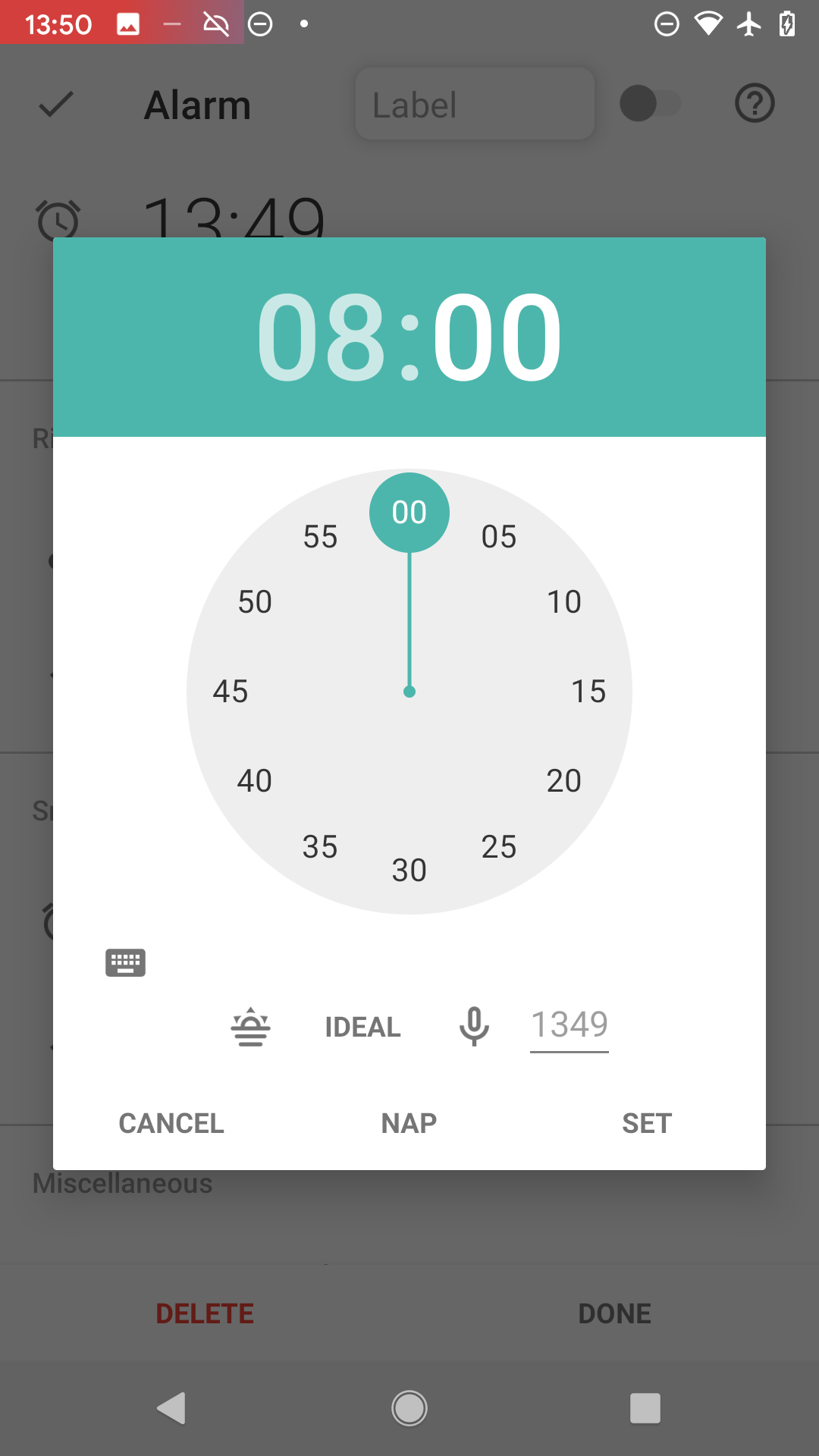 Figure 3. Tap on the desired time - minutes second
Figure 3. Tap on the desired time - minutes second -
Confirm the selected time with SET button, it will show you the new alarm settings. Confirm the alarm with DONE.
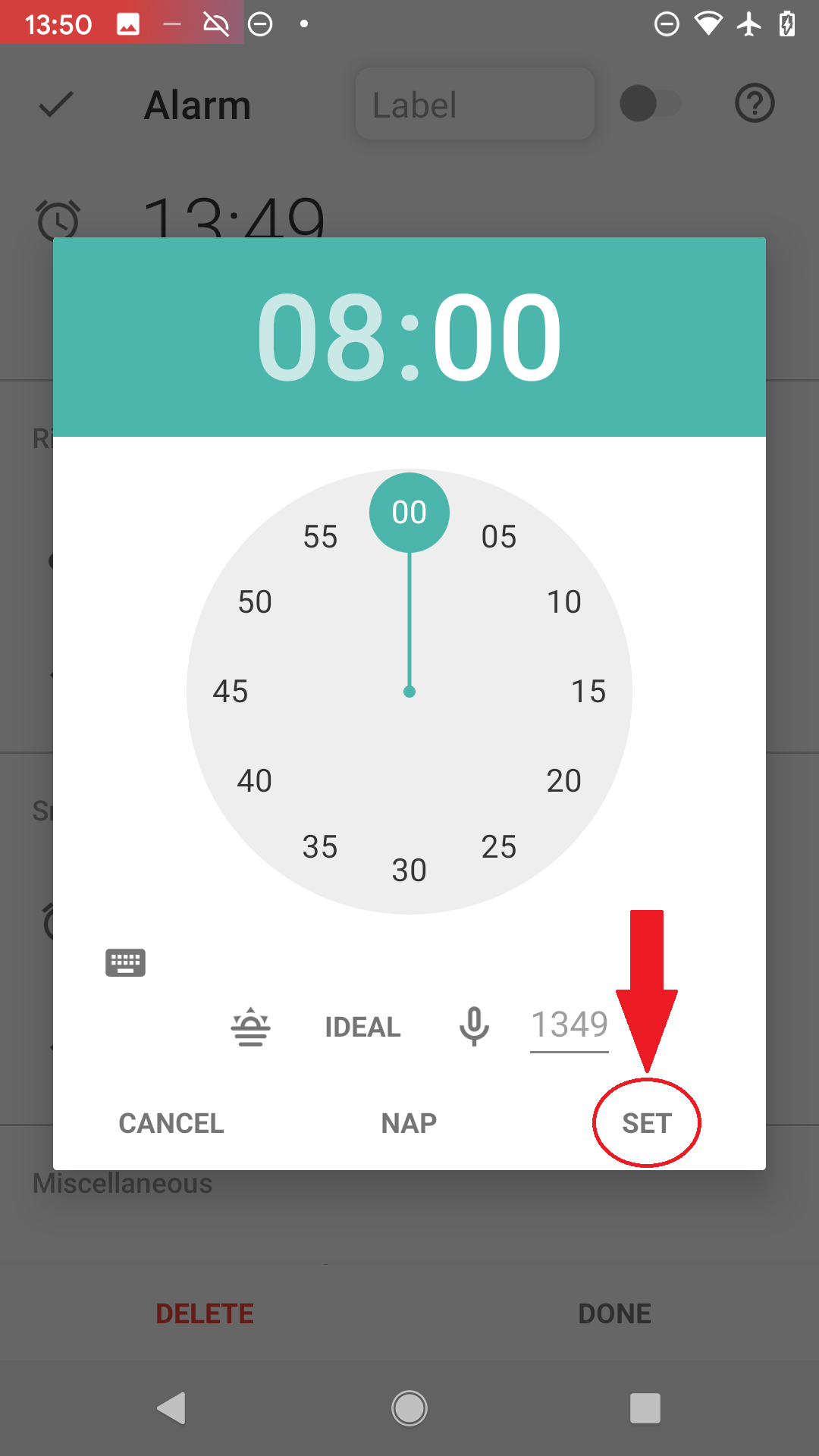 Figure 4. Confirm the time with SET button.
Figure 4. Confirm the time with SET button.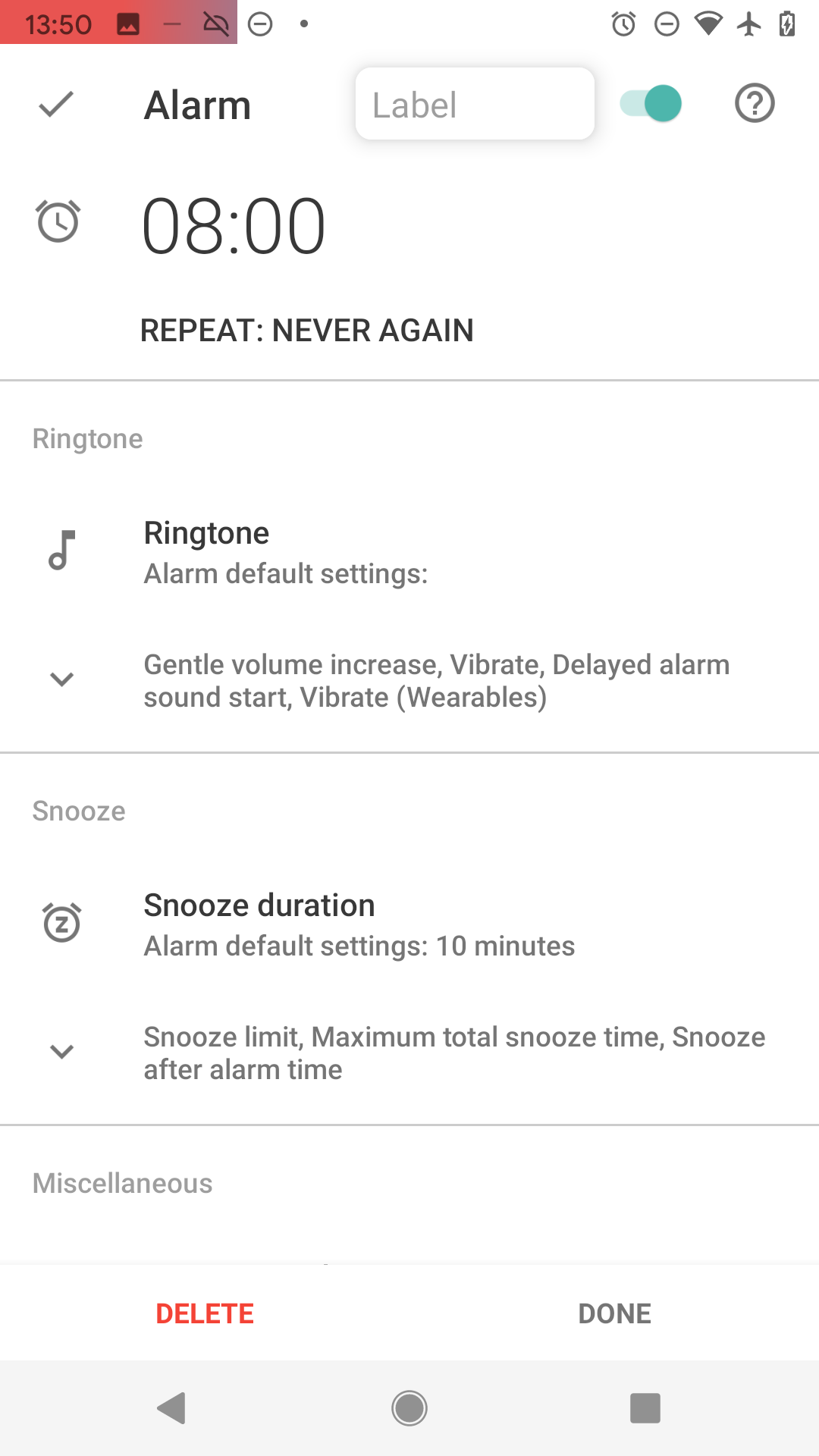 Figure 5. Now you see the new alarm’s settings.
Figure 5. Now you see the new alarm’s settings.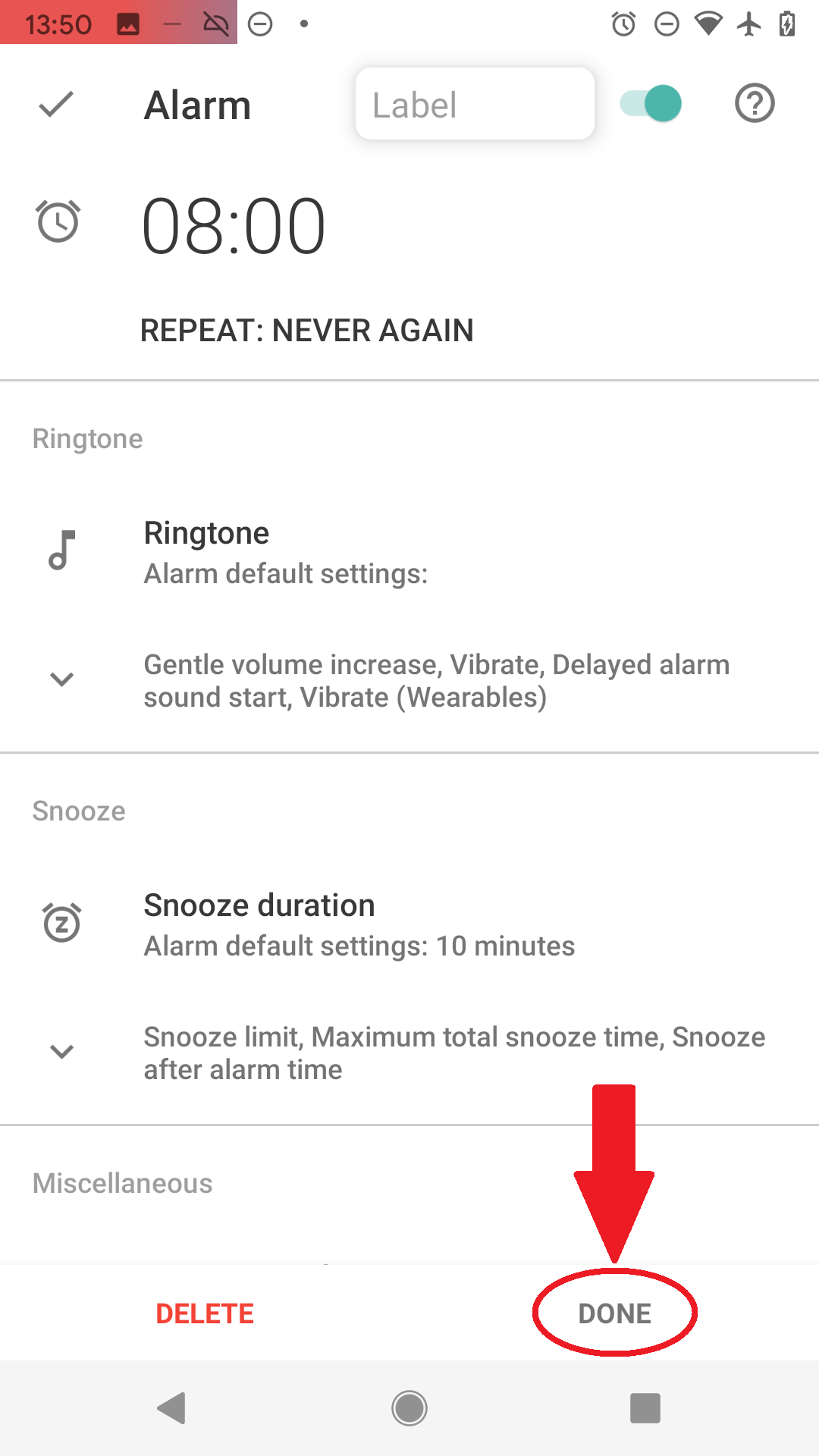 Figure 6. Confirm with DONE
Figure 6. Confirm with DONE -
Smart wake up makes sure to find the best time for your wake up between 7:30 – 8:00 based on your sleep cycle.
-
You can now see the alarm scheduled on the main screen.
-
Tap the moon and Sleep tracking starts, we use your phone’s sensor to find out what sleep phase you are in (see How it works).

We recommend turning on airplane mode during sleep tracking -
Now just place the phone on the mattress near your body (see Setup sleep tracking) so it is able to sense your movement and wake you in the right sleep phase to bring your wake up experience to a new level
-
After dismissing the alarm in the morning you will see your sleep phases, deep sleep % and more..
This can be the result of several things, so please try the following troubleshooting steps:
-
Make sure you have Sleep as Android Gear Addon installed on your phone and updated to the latest version.
-
It may happen that the addon can not be started by us if it was force stopped before. In this case, please go to the Play Store app on your phone, open addon page, tap "OPEN".
-
Disable all battery savers on your phone for all involved apps (Sleep as Android, Sleep as Android Gear Addon, Samsung Accessory Services) - to find out how to do this, please visit dontkillmyapp.com
-
Samsung Accessory Services sometimes misbehaves and prevents 3rd party apps from connecting to the watch. Please uninstall and reinstall it.
- Battery optimization has been enabled
-
When battery optimization is enabled, vibrations do not work, so the app loads the built-in ringtone to make sure you wake up.
-
Check Settings → Sleep tracking → Battery optimized.
-
Do not enable Save battery option from the Tracking screen → Stop and save pull up menu → Save battery.
- Phone has been restarted
-
-
If the phone screen is locked after a restart, the app cannot load any files.
-
The phone will ring with the built-in ringtone and vibrate.
-
We have had reports of audible artifacts during sonar tracking on some devices. It sounds like this:
Some of the signal gets into the audible range, probably due to either insufficient speaker quality or some post-processing applied to the output by your device’s firmware.
We also have some reports that Sonar can suddenly become audible while tracking at night. Unfortunately, we are not sure why this might happen, we have very few such reports, and we are not able to reproduce this on our phones.
To make any audible artifacts less likely:
-
Go to Settings → Sleep tracking → Test Sensor.
-
Try a different frequency from the drop-down menu list.
-
When you find the least affected frequency, you can try lowering the volume a bit (the slider). But keep it as high as possible to get reliable results.
|
|
If the volume needs to be adjusted, always confirm that sonar is still working - ideally after you change settings, try to sit calm in font of the test for few seconds and than move slightly - do you see a spike? |
If you get completely flat graphs with automatic tracking with sonar sensor after upgrading to Android 11, make sure the app has permission Draw over other apps, Display over other apps or Appear on top (Samsung).
This permission is necessary for accessing the microphone from the background.
-
System settings → Apps → Sleep → Appear on top / Display over other apps
-
System settings → Apps → More options (⁝) > Special access > Appear
on top / Display over other apps
If the tracking stops completely after few minutes, the background processes are restricted by your system.
-
Make sure no system restrictions are applied to Sleep as Android, or any companion app for a tracking with wearable: Check our guide here.
-
If the guide won’t help, send us your log using Left ☰ menu →
Support →
Report a bug.
-
Please make sure that you are not accidentally starting the Sleep as Android app from your watch. This would start sleep tracking immediately.
-
Make sure you are not using automatic start of sleep tracking in Settings → Sleep tracking → Automatic sleep tracking → Start sleep tracking.
You can find more information about automatic sleep tracking start here.
If you notice your volume gradually dropping after a while while tracking is running, the Turn off when sleeping is enabled. This feature lowers the system-wide volume, so it also affects music played outside of Sleep.
-
Go to Settings → Sleep tracking → Lullabies → Turn off when sleeping.
-
Increase the minimum play time (5-90 minutes).
-
Or disable the feature altogether by setting it to Disabled, and the app won’t change the volume.
|
|
When tracking with sonar, the volume must be kept at maximum to maintain reliable results. |
Unfortunately, this also affects media volume in third-party applications, and we cannot control those separately from Sonar’s media volume. This means that while using Sonar, you can only use media applications at full volume.
You can set a time delay to start tracking in Settings → Sleep Tracking → Awake Detection → Delayed Sleep Tracking.
- External Players
When using Sonar, you cannot use the volume buttons to control the media volume because it always jumps back to maximum.
- Lullabies
You can control the volume of lullabies from the Sleep app (Settings → Lullabies) and from Lullaby add-on pack - when you lower the volume with the volume buttons, the lullaby volume is estimated and adjusted accordingly, the Sonar volume is still kept at maximum.
Usually the battery consumption issue or related issues that cause the phone to overheat during sleep tracking are not directly caused by sleep tracking.
In most cases, sleep tracking itself does not consume too much battery (usually around 1-2% per hour of tracking). But because we keep a wake lock (keeping the phone awake), any other apps and processes can access the CPU extensively during the sleep tracking time. We would suggest checking what services are running before you go to sleep. Also, battery statistics are not a clue here, as all battery consumption goes to the app holding the wake lock, even if it did not consume the battery (this is by design in Android). This is hard for us to debug.
A good test would be to restart your phone (or kill any unnecessary services running) before using Sleep as Android and see if Sleep as Android still uses too much battery after that. One of the features of Sleep as Android that may cause higher CPU load during tracking is the noise recording. You can try tracking without it as a reference. We also strongly recommend tracking with airplane mode enabled.
The red block indicates that something went wrong with tracking at that time and the device stopped providing sensor data for some reason. Usually those are some non-standard battery optimizations or battery savers, the battery gets too low so we preserve it for the alarm or connectivity issue if you use a wearable.
1. Battery restrictions
Make sure no system restrictions are applied to Sleep, or any involved apps like wearable companion app).
See our guide here, and follow the instructions.
2. Too low battery
When the battery is too low (usually below 10%), data collecting is terminated to preserve enough battery for alarm.
When the battery was too low, there is a battery icon is displayed on the graph:
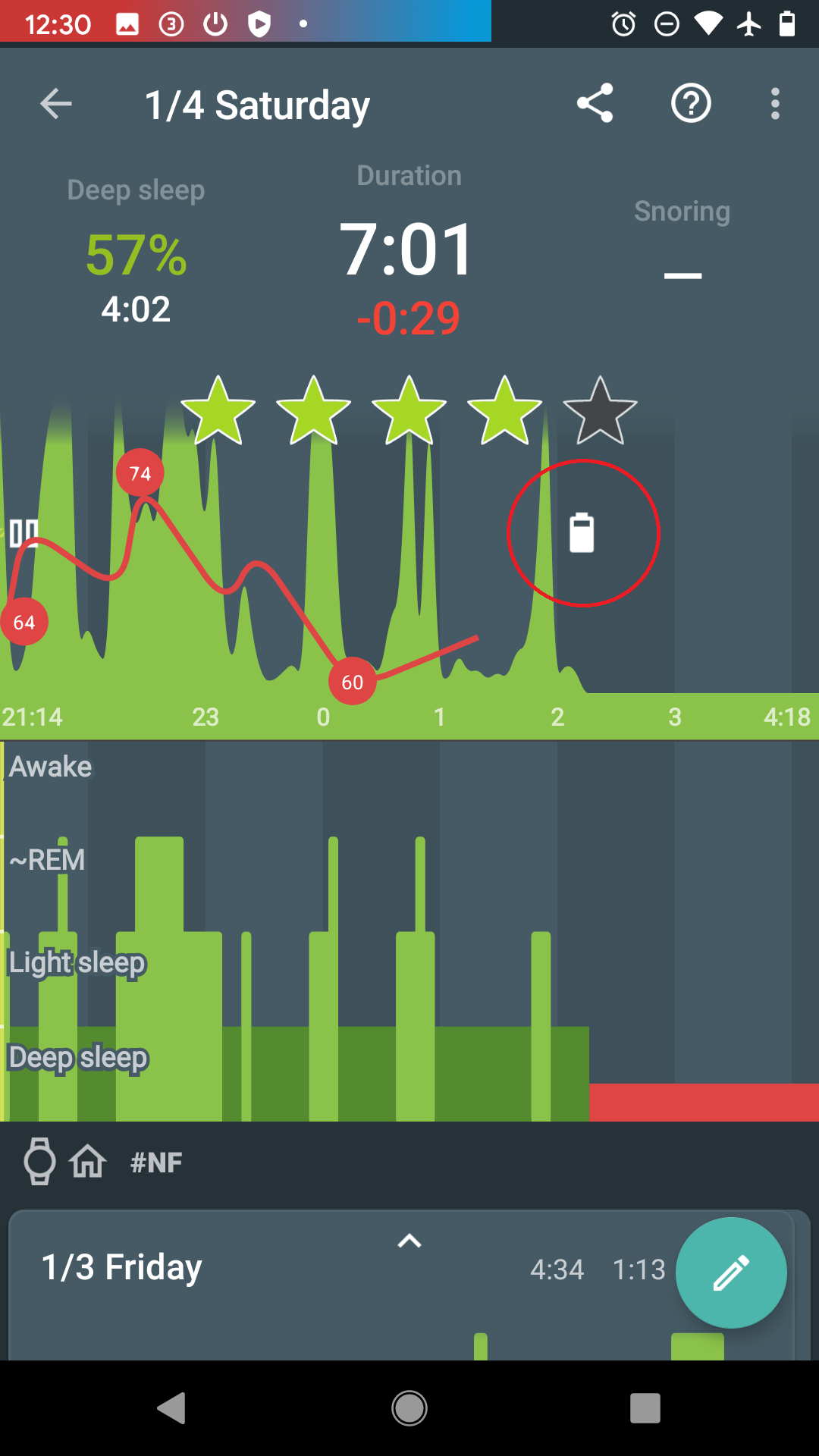
3. Connectivity issues with a wearable
When the connection with the wearable is lost, you can see red sections on the graph. The app always tries to reach the wearable again.
The graph can look like this:
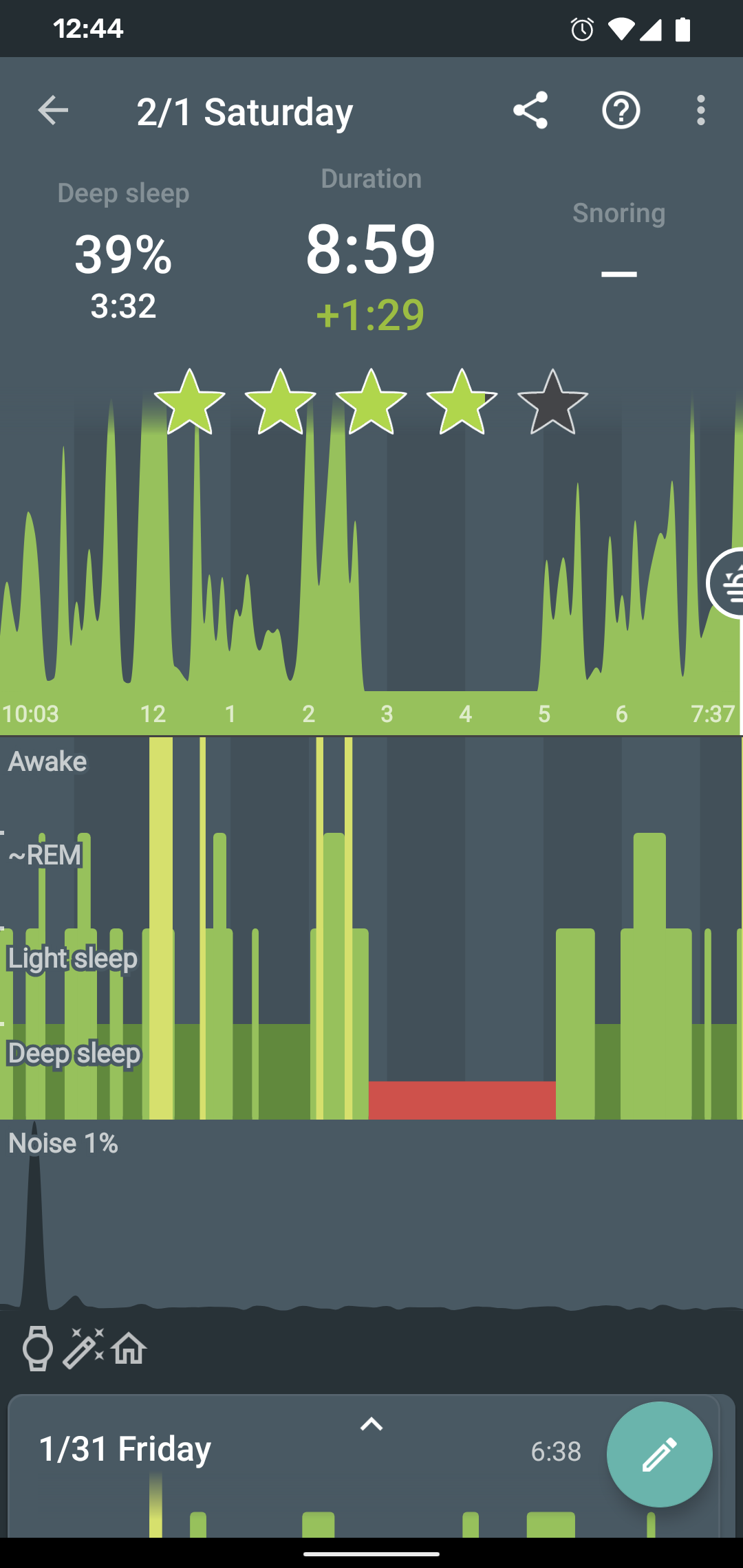
-
Opt-out from any battery restrictions is applied by your system (https://dontkillmyapp.com/)
-
Pair the wearable with your phone in System settings.
-
Make sure the BT is not lost, and try lowering the distance between the phone and the wearable.
-
Try settings the device as Trusted device.
Unfortunately, due to security restrictions introduced by the Android team in 4.2, there is no way to automatically enable airplane mode from an app. You always have to go into settings or long press the power button. If you have a rooted phone you might consider using https://play.google.com/store/apps/details?id=lv.id.dm.airplanemh we have support for this in Sleep. A similar hack exists for 4.3.
If you don’t agree with the Android team’s design decision, you can upvote issue 40497 here http://code.google.com/p/android/issues/detail?id=40497.
There is no clearcut answer to which day the sleep between them belongs.
We have decided to attach the sleep to the day after, because how you slept will largely determine how your day will be.
If you have separate mattresses there is minimum interference from your partner. If you have one big shared mattress (which isn’t recommended as you partner may need different mattress for his healthy sleep), it could still work assuming you keep your phone close to your body and ideally on your side of the bed.
You can also consider using a armbands or smartwatches. This certainly solves the problem for a little convenience trade-off.
If both of you are tracking, you can enable pair tracking, which filters out the partner’s activity.